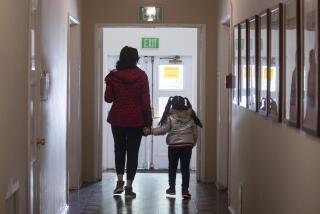A Place to Awaken From the Nightmare : For Some Children of Battered Women, Life in a Shelter May Be the Only Glimpse of Stability They’ve Ever Had
It looks like an ordinary housing complex: six adjoining cottages, each with kitchen and bath, sparse but comfortable furnishings, inviting front porches, a large common yard where children play like old friends.
But these are new and transient friends with a lot more in common than a yard. They are all living in a San Gabriel Valley shelter, hiding with their mothers from the batterer in their lives.
In cottage No. 3, four children sit around a table with their mom talking about how hard it is to live here.
The final blow in their parents’ stormy marriage came when their father accused their mom of looking at another man when she was trying to find her 7-year-old who had run off in a crowd. The incident ended with threats at gunpoint. Their mother sought safety at the Haven House shelter with the children.
Children of battered women who go to a shelter are often wrested, usually suddenly, from their schools, friends, and social and sports activities. They’re asked not to see friends in case the batterer should try to track down the mother through their connections. They have to leave their pets and toys. And some remain at the mercy of a mother who vacillates about whether or not to go home.
“As bad as home may have been, the kids in these shelters are homesick. They hang on to those few good times,” says Maria Michaels, clinical coordinator of Haven Hills Inc., a battered women’s shelter in Canoga Park. Haven Hills and the San Gabriel Valley shelter, Haven House, can each accommodate 36 people. Both shelters are usually full; two-thirds of the residents are children.
“Often the shelter is the first time these children have had any semblance of stability,” says Betty Grim, supervisor of the children’s program at Haven House. But, unlike the mother, who had a life view before she got into an abusive situation and who may understand that life doesn’t have to be like this, the kids don’t know that. They don’t know what normal is, she says.
But the four children who talked about their situation at Haven House know what normal isn’t. “He was mad a lot,” Juanita, 7, says of her father. “He made me feel bad. I’d go to my bed and cry.” (Juanita’s name, like the other children’s names in this story, has been changed.) Her 9-year-old brother, Jelo, describes the father as someone who “hits and screams when I make a mistake.”
The shelter offers some children the first safe place to talk. “I was too embarrassed to talk to my friends about my dad,” says George, 12. “But here everyone’s been through the same stuff.”
Despite being abruptly taken from her high school where she was a popular honor student, Mary Ann, 15, says of her father, “I wouldn’t mind not seeing him again.”
Even though life in the shelter means loss and a whole new set of fears, many children of battered women feel the way Mary Ann does. Of the children who come to Haven Hills, 65% suffer physical abuse from the father, Michaels says.
Others, however, do not harbor resentment toward their fathers. In some cases, the father indulges the children to make it harder for their mother to take them away.
In the 30 to 45 days battered women and their children have at most shelters--the time during which the mother is supposed to work out a more permanent relocation and survival plan--kids find their stay ending just as they’re getting used to the routine.
When the stay is up, they’re moving again, starting yet another school, meeting yet another circle of friends. More than half of their mothers return home. But Grim says that statistic is deceiving; of the women who go back, many leave again for good.
To help children regroup, shelters provide a sort of prep school for the future that includes academics, counseling, court preparation and activities.
School at Haven Hills takes place in a single room where one teacher tends to all grade and skill levels. At Haven House, children enroll in local schools. The shelter has an arrangement with the schools to protect the children’s identities.
At the shelter, Grim works to educate kids about domestic violence and substance abuse. “We work on self-esteem and body awareness and explain that no one has a right to harm you in any way. We also try to teach them what is normal.”
In addition, Grim says, the shelter organizes such family activities as nature walks and outings to museums and art shows. “So often the only thing dysfunctional families know how to do together is watch TV.”
Finally, counselors help families navigate the maze of logistics they face upon leaving. In the two weeks Mary Ann, George, Juanita and Jelo have been at Haven House, their mother has gotten a restraining order on her husband, qualified for financial help through Aid to Families with Dependent Children and gotten into a training program that will help her resume the type of work she did before she married. Next, family counselors will help her find housing in a new community where the family can start fresh.
Mary Ann worries most about the fresh start. She dreads starting yet another new school. Juanita, on the other hand, says her biggest worry is that “Dad might find us and hit us.”
Although it’s hard for these kids to erase their past and start over, Grim says some erasures are good erasures. “Maybe the home life wasn’t so great. Maybe it was like a nightmare and you’re glad to have woken up.”
In spite of the pain and turmoil, some kids see Grim’s point and agree that they’re on the best of two rough roads. “I want to go to college and this might make it harder,” George says, “but it feels better here.”
More to Read
Sign up for Essential California
The most important California stories and recommendations in your inbox every morning.
You may occasionally receive promotional content from the Los Angeles Times.










